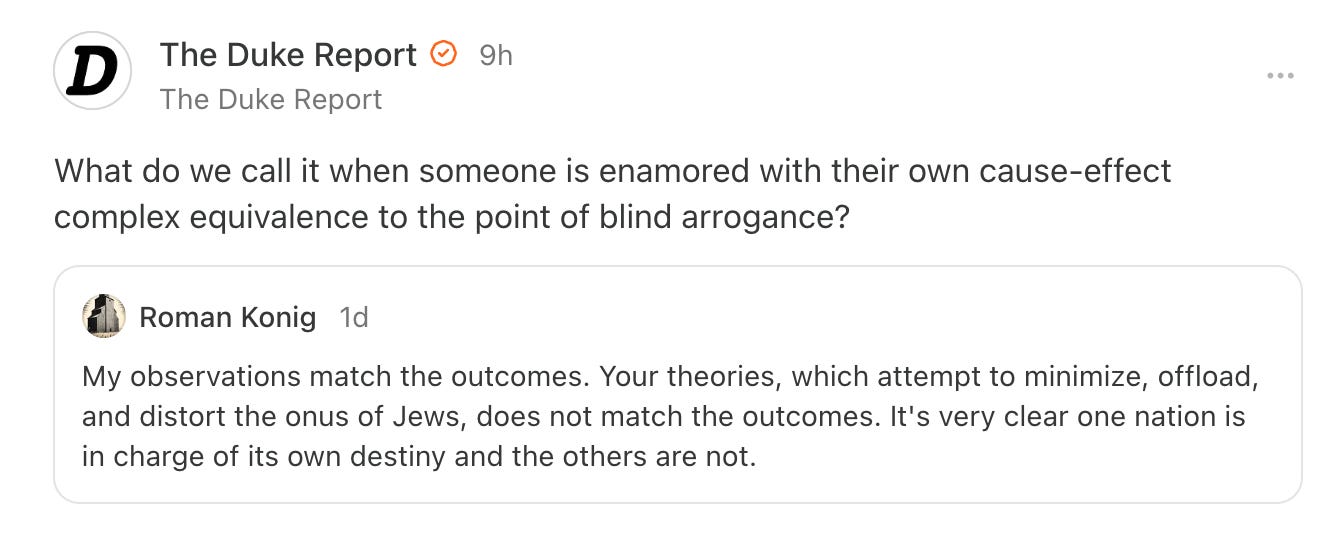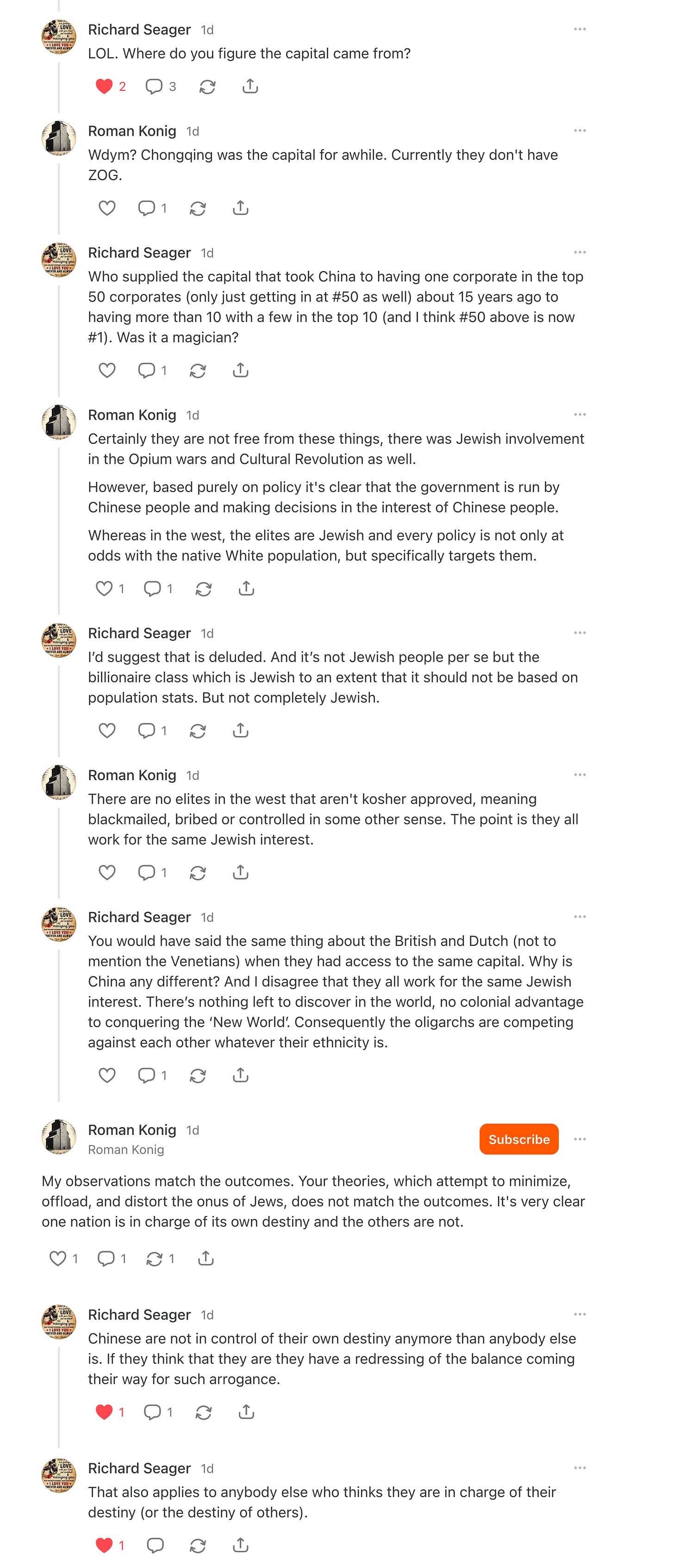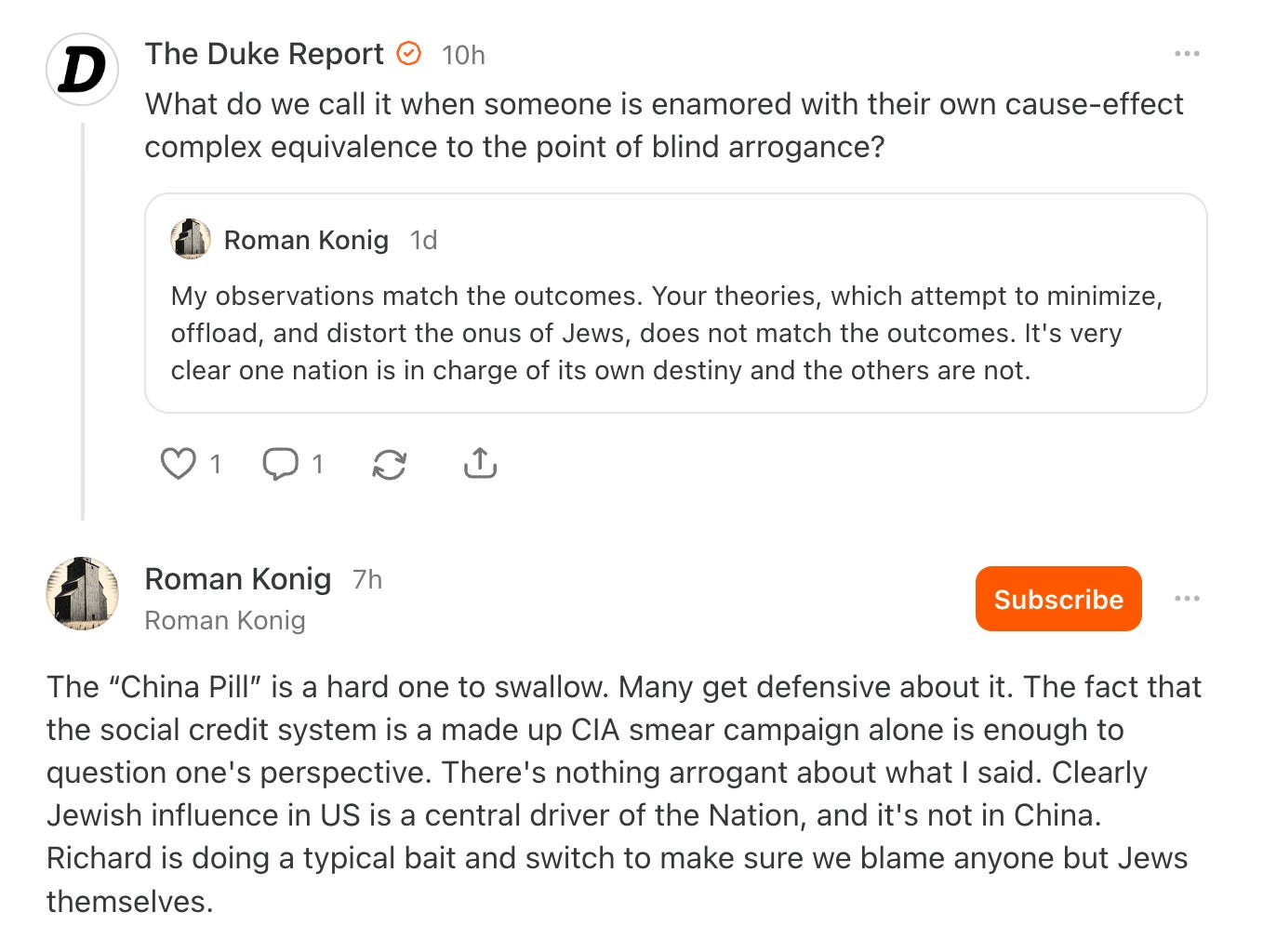Weaponized Comments
A Case Study in EpiWar™️, Chaos Agents, and the Discipline of λόγος
Introduction to the Exercise
SubStack is usually a cut above Twitter, insofar as comments go, but today I saw a thread that gave me pause, between “Roman Konig” and Richard Seager.
The thread started as a complex equivalence statement by Global GeoPolitics about China, but quickly devolved into some nonsense about, you-guessed-it, “the jews.”
Make no mistake. I believe there are ubiquitous Zionist influences in the world, and I also believe that they are partners and pawns of the Anglo-American Establishment, Crown Empire, Cryptocracy, Military Occult Banking Syndicate, Power Elite – whatever you wish to call them – and act as a bulwark against direct attack.
When I first quoted this comment from "Roman Konig", I errantly framed it as “arrogant” (see screenshot immediately below). My Bad.
That was a presupposition on my part, and it narrowed the possibilities. The text might have easily been read as other explanations, such as unexamined reasoning, as a sincerely held but distorted belief, as deliberate disruption by a Chaos Agent, or as something else.
To be fair, all of these possibilities should remain open.
For context, here is the thread that I was referencing:
Seager appears to have far greater historical context than Konig. From there, the thread devolved:
Thanks to the generosity of my readers, all my articles are available for free access. Independent journalism, however, requires time and investment. If you found value in this article or any others, please consider sharing or even becoming a paid subscriber, who benefits by joining the conversation in the comments. I want you to know that your support is always gratefully received and will never be forgotten. Please buy me a coffee or as many as you wish.
It is not often that I see the density of knowing/non-thinking and linguistic tomfoolery happening in such a small space, and I quickly quoted a glib comment without enough forethought.
Konig engaged with similar aplomb.
At this point, I was going to re-engage, but on second thought, I decided that there was so much material to work with that I might use this as a teachable moment for my readers. What follows are the lessons to be gleaned from Konig’s perilous line of posting.
I’m not going to touch much on Konig’s lack of historical context. (He could start here.) I will focus on linguistic and Metahistorical errors, along with their remedies.
This exercise will treat each sentence as a case study in EpiWar™️ tactics (whether intended or not). The goal is to map the distortions in the language itself — how words install frames, mask assumptions, and create the illusion of proof.
Each sentence will be examined in turn, with linguistic distortions identified and logic errors (noted only when they are blatant). The method applies λόγος (structured application of language) and κρίσις (discernment) as a remedy to show how language can either point to truth or confuse beliefs.
Sentence 1 (Konig’s Quoted Comment RE Seager)
“My observations match the outcomes.”
Neurolinguistic Distortions
Nominalization: “Observations” and “outcomes” are abstract, undefined, and static.
Lost Performative: “Match” still implies evaluation, but without any stated standard or measure.
Deletion: The act of observing and the process by which outcomes are assessed disappear, leaving only the conclusion.
Authority by Assertion: By framing it in the first person (“My”), the sentence places private experience as its own validation.
Presupposition: Assumes that the outcomes exist, are agreed upon, and are accessible to all participants in the discussion.
Logic Error (blatant)
Correlation ≠ Causation: The leap from “my observations” to “matching outcomes” slides correlation into explanation.
Possibilities Beyond Arrogance (My Bad)
The “My” is subjective, authoritative anchoring: a focus on personal vantage rather than shared criteria. That may reflect a limitation of perspective rather than arrogance.
It could be a Chaos Agent tactic: “My” as a rhetorical shield, making the statement unassailable since it rests on personal authority.
It could reflect epistemic closure: the writer confuses private observation with universal proof, closing the frame to further scrutiny.
λόγος + κρίσις repair
Anchor referents: Replace “My” with a clear statement of method—who observed, under what conditions, using what tools.
Define criteria: What counts as a “match”? Correlation? Prediction? Repetition?
Ground in evidence: Provide data, timeframe, and source.
Model rewrite (structural template)
“In [context], I observed [specific data]. That aligns with [defined outcome] by [criteria], supported by [evidence].”
Sentence 2 (Konig’s Quoted Comment RE Seager)
“Your theories, which attempt to minimize, offload, and distort the onus of Jews, does not match the outcomes.”
Neurolinguistic Distortions
Nominalization: Theories and onus are abstract, static nouns without definition or scope.
Cause–Effect Complex Equivalence: Theories are equated with attempts to minimize, offload, and distort. This collapses description into accusation.
Presupposition: Assumes an onus of Jews exists, assumes the interlocutor’s theories aim to distort it, and assumes “outcomes” exist and are settled.
Loaded Language: “Minimize, offload, and distort” pre-frame the theories as deceitful without demonstration.
Lost Performative: Does not match the outcomes implies a standard of truth-testing but never states the criteria for what counts as a match.
Deletion: The content of the theories is not described, nor are the outcomes specified.
Authority by Assertion: The sentence delivers judgment without evidence, framing the conclusion as self-evident.
Logic Error (blatant)
Non Sequitur: Even if theories differ from claimed outcomes, that alone does not prove distortion or bad intent.
Possibilities Beyond Arrogance (My Bad)
Could signal projection: by accusing the other side of distortion, the speaker shields their own claims from scrutiny.
Could serve as a Chaos Agent tactic: shifting focus to “onus of Jews” reframes the discussion into a charged identity claim, destabilizing the exchange.
Could reflect epistemic closure: the writer treats their interpretation of “outcomes” as universal and immune to challenge.
λόγος + κρίσις Repair
Define terms: What theories? What “onus”? What “outcomes”?
State criteria: On what measure does a theory “match” an outcome? Predictive accuracy? Explanatory coherence?
Separate observation from evaluation: Show what the theory says, then test it against evidence.
Model Rewrite (structural template)
“The theory [name/description] claims [X]. When compared against [specified outcomes/data], it fails to align because [criteria].”
Sentence 3 (Konig’s Quoted Comment RE Seager)
“Your theories, which attempt to minimize, offload, and distort the onus of Jews, does not match the outcomes.”
Neurolinguistic Distortions
Nominalization: Theories and onus are abstract, static nouns without definition or scope.
Universal Quantifier: Onus of Jews assigns a singular responsibility to all members of a group defined by immutable characteristics, erasing individuality.
Cause–Effect Complex Equivalence: Theories are equated with attempts to minimize, offload, and distort. Description collapses into accusation.
Presupposition: Assumes an onus of Jews exists, assumes the interlocutor’s theories aim to distort it, and assumes “outcomes” exist and are settled.
Loaded Language: “Minimize, offload, and distort” pre-frame the theories as deceitful without demonstration.
Lost Performative: Does not match the outcomes, implying a standard of truth-testing, but never states the criteria.
Deletion: The content of the theories is not described, nor are the outcomes specified.
Authority by Assertion: The sentence delivers judgment without evidence, presenting the conclusion as self-validating.
Logic Error (blatant)
Non Sequitur: Even if theories differ from claimed outcomes, this does not prove distortion or deceit.
Philosophical Stakes
The phrase onus of Jews denies free will by treating responsibility as collective inheritance, not as individual choice.
This stance opposes the Western tradition of individuality, rooted in Greek, Christian, and Enlightenment thought, where accountability belongs to the person.
By collapsing individuality into immutable group identity, the wording mirrors the ideological structure of Nazism: collective guilt, racial determinism, and persecution justified through language.
Metahistorical Trope
Metonymy: Implies an inevitable burden (“onus”) carried by a people as collective fate.
Possibilities Beyond Arrogance (My Bad)
It could serve as a projection: accusing others of distortion to shield the fragility of the claim.
It could operate as a Chaos Agent tactic: shifting the discussion into group blame to destabilize dialogue.
Could reveal epistemic closure: treating one interpretation of “outcomes” as universal and beyond challenge.
λόγος + κρίσις Repair
Define terms: Which theories? What “onus”? What “outcomes”?
State criteria: On what measure does a theory “match” an outcome?
Remove universal quantifier: Attribute responsibility to specific agents, actions, and evidence — not to groups defined by birth.
Restore individuality: Keep moral and causal responsibility tied to persons and choices, not collective essence.
Model Rewrite (structural template)
“The theory [name/description] claims [X]. When compared with [specified outcomes/data], it diverges because [criteria]. Responsibility for [event/outcome] is traced to [specific actors/decisions], not to a group as a whole.”
Sentence 4 (Konig’s Response to my Quote)
“The ‘China Pill’ is a hard one to swallow.”
Neurolinguistic Distortions
Nominalization / Reification: China Pill condenses multiple undefined claims into a single object-word.
Presupposition: Assumes a coherent “pill” exists, and that “swallowing” it is the correct mode of engagement.
Lost Performative: Hard to swallow asserts difficulty without giving criteria — what makes it hard? Complexity? Contradiction? Offensiveness?
Deletion: Erases the content of the “pill” — the propositions themselves are not stated.
Binary Closure: Swallow vs. refuse creates a false binary.
Thought-Terminating Cliché: “Hard pill to swallow” is a stock phrase that discourages inquiry.
Logic Errors (blatant)
False Dilemma: Implies the only options are acceptance or resistance, eliminating possibilities like partial agreement, critique, or reformulation.
Philosophical Stakes
Shifts focus from examining claims (λόγος) to testing loyalty — acceptance becomes the only valid response.
Substitutes ritual (swallowing) for discernment (κρίσις).
Establishes epistemic identity: those who “swallow” are insiders, those who resist are outsiders.
Metahistorical Trope
Metaphor: The “pill” casts truth as a mythic ordeal — swallowing is framed as a heroic initiation into hidden knowledge.
Possibilities Beyond Arrogance (My Bad)
Could be Chaos Agent framing: binary setup designed to polarize.
This could be an example of epistemic closure: equating belief with courage, thereby bypassing scrutiny.
Could be propaganda mimicry: recycling a cliché as a gatekeeping device.
λόγος + κρίσις Repair
Unpack the “pill” into explicit propositions.
Replace metaphor with clear, testable claims.
Define criteria for difficulty: technical, moral, or evidentiary challenge?
Open the frame: allow for analysis, modification, or rejection of parts.
Model Rewrite (structural template)
“By ‘China Pill’ I mean [P1, P2, P3]. These claims challenge [framework] because [evidence]. The difficulty lies in [defined criteria].”
Sentence 5 (Konig’s Response to my Quote)
“Many get defensive about it.”
Neurolinguistic Distortions
Lost Performative: The evaluation defensive is asserted without criteria. What counts as defensive behavior? Raised voice, refusal to agree, counter-argument? No standard is provided.
Unspecified Referential Index: Many is vague. Which people, in what context, how many, observed when?
Presupposition: Assumes defensiveness occurs in response to the “China Pill” without evidence.
Deletion: Provides no examples, quotes, or events showing this alleged defensiveness.
Cause–Effect Complex Equivalence: Suggests that encountering the “China Pill” causes defensiveness, smuggling causality into a correlation.
Authority by Assertion: Poses as common knowledge, requiring no proof.
Logic Errors (blatant)
Hasty Generalization: Generalizes from unspecified instances to a broad claim about “many.”
Philosophical Stakes
Shifts debate from the truth of claims to the psychology of opponents.
Frames critique as emotional weakness, thereby discrediting disagreement without engaging λόγος.
Bypasses κρίσις (discernment) by reclassifying counter-argument as fragility.
Possibilities Beyond Arrogance (My Bad)
Could be Chaos Agent framing: dismissing critics by coding them as emotionally unstable.
Could be projection: attributing fragility to others as a shield against scrutiny.
Could be epistemic closure: reframing disagreement as psychological resistance rather than substantive critique.
λόγος + κρίσις Repair
Replace “many” with concrete referents: who, where, and when.
Define criteria for “defensive”: observable behaviors, not vague labels.
Provide evidence: cite actual examples of reactions to the “China Pill.”
Separate emotional claim from truth claim: establish whether disagreement stems from evidence, not psychology.
Model Rewrite (structural template)
“In [context], when the claim [X] was presented, [defined group] responded by [specific behavior]. I classify that as defensive because [criteria].”
Sentence 6 (Konig’s Response to my Quote)
“The fact that the social credit system is a made up CIA smear campaign alone is enough to question one’s perspective.”
Neurolinguistic Distortions
Nominalization: The fact turns an assertion into a settled truth, bypassing scrutiny.
Presupposition: Assumes the system is fabricated despite wide evidence of its existence. Assumes CIA authorship and smear as motive.
Lost Performative: Is enough claims sufficiency without standards — enough for whom, under what criteria?
Deletion: Leaves out all evidence contradicting the claim, erasing the reality of the system’s documented features.
Overloaded Claim: Packs three separate assertions into one unit (nonexistence, CIA authorship, smear campaign).
Unspecified Referential Index: One’s perspective is vague — which perspective, and on what issue?
Authority by Assertion: Leads with “the fact” to mask speculation as certainty.
Logic Errors (blatant)
Contradiction of Evidence: Denies a system that is well documented in Chinese law and practice.
Non Sequitur: Even if the CIA amplified narratives about the system, this does not make the system itself “made up.”
Overgeneralization: Treats suspicion of US intelligence as proof of fabrication.
Philosophical Stakes
Collapses λόγος by equating speculation with fact.
Short-circuits κρίσις by forcing a single conclusion: if it’s CIA-made, then all perspectives must shift.
Trains epistemology on institutional suspicion rather than evidence, a classic EpiWar™️ move.
Metahistorical Tropes
Irony: Reverses reality — something widely documented is reframed as entirely fictitious, a mocking inversion of evidence.
Metaphor: Implies a hidden revelation — seeing through the “smear” is framed as awakening from illusion.
Possibilities Beyond Arrogance (My Bad)
Could be Chaos Agent framing: designed to erode confidence in empirical reality.
It could be epistemic closure: denial of evidence in order to preserve a fixed worldview.
This could be propaganda mimicry: the repetition of counter-narratives crafted to destabilize trust in institutions.
λόγος + κρίσις Repair
Acknowledge the phenomenon as documented.
Distinguish between existence of the system and interpretation of its function.
Clarify CIA role, if any, in shaping global perception, with evidence.
Remove “the fact” — replace with “the claim” or “the argument.”
Specify referent: whose perspective is under question?
Model Rewrite (structural template)
“The Chinese social credit system exists and is documented in [sources]. Some argue that Western narratives about it have been amplified by intelligence agencies to frame China negatively. If that claim is accurate, it raises questions about [specific perspective].”
Sentence 7 (Konig’s Response to my Quote: Correction Point)
“There’s nothing arrogant about what I said.”
This denial is 100% accurate. The charge of arrogance came not from the statement itself but from my editorial framing.
The legitimate question was: “What do we call it when someone is enamored with their own cause-effect complex equivalence?”
By adding “…to the point of blind arrogance,” I narrowed the inquiry into a binary of arrogance vs. denial, distracting from the real object of analysis: the structure of reasoning.
This moment demonstrates the importance of surfacing our own presuppositions. Analysts, too, must guard against introducing distortions.
Sentence 8 (Konig’s Response to my Quote)
“Clearly Jewish influence in US is a central driver of the Nation, and it’s not in China.”
Neurolinguistic Distortions
Universal Quantifier: Jewish influence is framed as a collective essence, attributed across an entire religioethnic group.
Nominalization: Influence and Nation are abstracted into static objects with no actors or mechanisms identified.
Lost Performative: Clearly signals self-certification without criteria.
Presupposition: Assumes “Jewish influence” exists, assumes it is central, and assumes its role is settled knowledge.
Deletion: No institutions, individuals, or concrete processes are identified.
Authority by Assertion: The claim validates itself as an obvious truth.
Logic Errors (blatant)
Fallacy of Composition: This fallacy involves taking the actions of some individuals or groups and projecting them onto all members of a religion.
Reductionism: Collapses the complexity of US political, financial, and cultural systems into a single driver.
Philosophical Stakes
Denies individuality and free will by binding responsibility to immutable identity.
Contradicts the core of λόγος and κρίσις, which test claims against evidence rather than asserting group essence.
Encodes the ideological structure of Nazism: collective guilt, racial determinism, and persecution justified by abstraction.
Metahistorical Tropes
Metonymy: Treats “Jewish influence” as an inherited burden that defines historical outcomes.
Metaphor: Implies a hidden, singular force steering national destiny — a mythic driver substituting for concrete analysis.
Possibilities Beyond Arrogance (My Bad)
Could be Chaos Agent framing: shifting focus from structural analysis to group blame.
Could be epistemic closure: a worldview that collapses complexity into essentialist identity.
Could be propaganda mimicry: recycling deterministic anti-Semitic tropes.
λόγος + κρίσις Repair
Define referents: Identify which institutions, actors, and decisions are meant.
Replace nominalizations with actions: Influence must be described in terms of what is done, by whom, and how.
Eliminate universal quantifiers: Responsibility attaches to specific choices, not inherited group identity.
Keep the scope open: acknowledge systemic, cryptocratic, and supra-national structures that shape outcomes.
Model Rewrite (structural template)
“Policy in the United States is shaped by [specific institutions, lobbies, or organizations] in areas such as [domain]. Influence results from defined actions and mechanisms, not from collective identity.”
Sentence 9 (Konig’s Response to my Quote)
“Richard is doing a typical bait and switch to make sure we blame anyone but Jews themselves.”
Neurolinguistic Distortions
Cause–Effect Complex Equivalence: Equates Richard’s action with the effect of deflecting blame. No mechanism is explained.
Lost Performative: Typical bait and switch is asserted without criteria. What defines “bait and switch”? Typical for whom?
Presupposition: Assumes (1) Richard is engaged in manipulation, (2) there is blame to be assigned, (3) the rightful target of blame is “Jews themselves.”
Universal Quantifier: “Jews themselves” assigns guilt collectively to a whole religioethnic group.
Deletion: No evidence of what Richard said or did is provided.
Loaded Language: “Bait and switch” pre-frames Richard as deceptive without analysis.
Authority by Assertion: Judgment is delivered as fact, with no substantiation.
Logic Errors (blatant)
Ad Hominem: Discredits Richard by attacking his intent (“typical bait and switch”) rather than engaging the substance of his argument.
Begging the Question: Assumes the very point at issue — that Jews are to blame — and uses Richard’s alleged “bait and switch” as proof.
Fallacy of Composition: Treats a group identity as the rightful bearer of blame.
Philosophical Stakes
Replaces inquiry with scapegoating.
Denies individual responsibility and free will by attributing guilt to an entire group.
Embeds the ideological structure of Nazism: collective guilt tied to immutable identity.
Blocks λόγος (analysis of Richard’s actual argument) and κρίσις (testing its validity) by reclassifying debate as manipulation.
Metahistorical Tropes
Metonymy: Collective guilt as tragic burden — “Jews themselves” carry blame across time.
Irony: The claim inverts discourse — portrays engagement with complexity as deception, while asserting collective blame as truth.
Possibilities Beyond Arrogance
Chaos Agent tactic: destabilize the discussion by attacking the interlocutor and inflaming group blame.
Projection: accuses Richard of manipulation while smuggling manipulation into its own language.
Propaganda mimicry: repetition of a rehearsed anti-Semitic frame disguised as debate.
λόγος + κρίσις Repair
Remove motive attribution: analyze Richard’s argument on its merits.
Define “bait and switch”: specify what was presented and how it allegedly shifted.
Eliminate universal quantifier: attribute responsibility only to specific claims, actors, or evidence.
Test the claim: if blame is asserted, ground it in actions, not identity.
Model Rewrite (structural template)
“Richard argued [X]. I interpret this as a shift because [criteria]. Responsibility for [issue] lies with [specific actors/decisions], not with any collective identity.”
Conclusion
This exercise has shown how distortions operate in language: nominalizations that freeze process into objects, universal quantifiers that erase individuality, presuppositions that smuggle assumptions, deletions that obscure evidence, and cause–effect equivalences that masquerade as proof.
We also saw how metahistorical tropes — Metaphor, Metonymy, and Irony — give arguments a mythic texture that makes them feel inevitable.
The sequence ends with outright scapegoating. By naming “Jews themselves” as the inevitable target of blame, the text abandons analysis and falls into collective determinism. This is the endpoint of unchecked distortion: argument dissolves into ideological assertion.
But the critical moment for me was earlier, at Sentence 7, where I, as the commenter, caught myself. Konig’s denial was accurate. My own editorial phrase — “to the point of blind arrogance” — had introduced a presupposition that narrowed the field. I violated my own rules. That moment became my correction point: the place where I had to admit my own framing error and return the focus to structure, not motive.
The final takeaway for students is double:
Distortions in language can be mapped and repaired through λόγος (structured analysis) and κρίσις (discernment).
Analysts themselves must guard against inserting their own distortions. When motive-frames slip in, they must be corrected, so the inquiry stays open and focused on structure rather than scapegoating.
That is the discipline of epistemological analysis: to expose distortions in others’ language, and to remain vigilant against distortions in our own.















https://x.com/robinmonotti/status/1966015081189101593?s=61
I think what’s going down now with Charlie Kirk is a clear case of weaponized comments
The hateful comments about his death seem over-the-top & out-of-place - more akin to the vitriolic comments that were spewed out during Covid - after which we found out there was a huge influencer $$$ disinformation campaign
To me this seems more the case of what’s happening here - a few paid influencers set the trend of tone (in many camps) a throng of reaction follows as most people are played to higher social engineering ends
Robert Epstein has done some great exposure of the manipulation of online media through subtle obscure channels